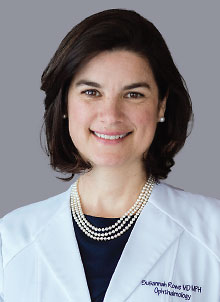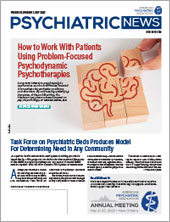Nearly one-fourth of physicians who work at a large academic medical center have experienced mistreatment such as sexual harassment or abuse; verbal mistreatment or abuse; or physical intimidation, violence, or abuse on the job in the past 12 months, a study in JAMA Network Open has found. Patients and visitors were the most common source of mistreatment, followed by other physicians.
“The fact that patients and family members were the most common source of mistreatment aligns with what we are hearing around the country,” lead author Susannah G. Rowe, M.D., M.P.H., told Psychiatric News. She is an ophthalmologist at Boston University School of Medicine, associate chief medical officer of wellness and professional vitality at Boston Medical Center, and chair of the Wellness and Professional Vitality Council at Boston University Medical Group.
“Effective strategies will require a multidisciplinary approach with experts in patient experience, patient advocacy, health equity, public safety, and workforce well-being,” Rowe said.
Rowe and colleagues analyzed data from 1,505 physicians at Stanford University School of Medicine who responded to a survey on workplace mistreatment and occupational well-being in September and October 2020. The survey included questions from the Professional Fulfillment Index, which measures employees’ intent to leave, and the Mistreatment, Protection, and Respect Measure, which measures respondents’ perceptions of protective factors in the workplace such as the existence of institutional systems that ensure employees are treated with respect and the presence of bystanders who speak up or intervene when they witness mistreatment or abuse. Physicians were asked if they experienced sexual harassment or abuse, including sexual comments or jokes, inappropriate sexual attention, unwelcome advances, or requests for sexual favors; verbal mistreatment or abuse, including use of slurs, insulting jokes or humor, name calling, swearing, yelling, intimidation, verbal attacks, nonphysical threats, or warnings about retaliation; and physical intimidation, violence, or abuse, including direct or implied threats of violence, threatening gestures or symbols, pushing, shoving, throwing things, and assault such as sexual or racial assault.
Of 1,397 physicians who answered questions about mistreatment, 23.4% reported experiencing mistreatment in the last 12 months. Patients and visitors were the most common source of mistreatment, accounting for 70.9% of all mistreatment events as reported by 16.6% of physicians. Other physicians were the second most common source of mistreatment, reported by 7.1% of respondents.
Verbal mistreatment was the most frequent form of mistreatment, reported by 21.5% of physicians, followed by sexual harassment and physical intimidation, reported by 5.4% and 5.2% of respondents, respectively. Women were more than twice as likely as men to experience mistreatment, and multiracial and Black physicians were more likely than White and Asian physicians to report experiencing mistreatment.
“We didn’t have enough information to draw conclusions about other genders or to explore incidence by specific race or ethnicity categories, but our findings suggest that workplace mistreatment is higher for physicians who are not White and those who are not male,” Rowe explained. “This disparity suggests that some of the mistreatment is very likely rooted in gender- and race-based biases.”
Rowe said that although this research involved only one medical facility, it aligns with reports of frequent mistreatment of health care workers throughout the country and is part of an overall trend of disrespectful behavior.
“The recent erosion of norms of civility, together with the enormous stressors of the pandemic, the rise of mental illness and opioid use disorders, financial insecurity, loss of public trust, politicization of medical care, and race- and gender-related trauma all contribute to people behaving poorly in every industry, and especially in health care,” Rowe said.
The Impact of Mistreatment
Mistreatment of physicians can have a profound effect on care, especially if they do not feel supported in their workplace. Physicians who perceived that there were no systems in place to protect against mistreatment had 711% higher odds of intending to leave, scored higher on measures of burnout, and scored lower on measures of professional fulfillment compared with those who believed such systems were in place.
Rashi Aggarwal, M.D., a member of APA’s Council on Medical Education and Lifelong Learning, said that despite all the training physicians have, being mistreated can affect their perception of their patients. Aggarwal is the director of the residency training program and a professor in the Department of Psychiatry at Rutgers New Jersey Medical School.
“If visitors or patients have been verbally abusive, they can be perceived as difficult and in general there will be a tendency among staff to want to get them out [of the facility],” said Aggarwal, who was not involved in the research. “It’s never pleasant to hear slurs against you or be yelled at, so it is important to have a support system in place when it happens, someone to talk to about it and help you work it out, and also time to process what happened and think about it.”
Aggarwal said that being short-staffed after physicians leave their jobs also affects care.
“It’s not a small thing when there is a vacancy,” Aggarwal said. “It can mean a long wait for patients, or even not being able to get in to see someone. Having an environment where people want to come to and feel supported is important.”
Aggarwal noted that hospitals and other health facilities are set up to take care of patients, and rightfully so, but that the safety and well-being of physicians and other health care workers must also be a priority. “We come into this profession to take care of people, and we are patient centered because patients are in pain, but what about the women and minority physicians who have been taking this kind of trauma all of their lives? It’s not OK to tolerate this in the workplace. You have to take care of everyone involved.” The authors did not report any outside funding for this study. ■


